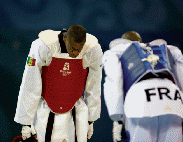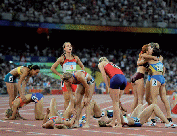Урок-дискуссия «Sport can change the world» («Спорт может изменить мир») Ориентирован на старшую возрастную группу (10-11 классы).
Цель: сформировать представление учащихся об основных ценностях Олимпийского движения, направленные на пропаганду олимпийского перемирия и их воплощение в современном обществе.
Задачи:
— привлечь внимание учащихся к проблемам олимпийского движения, ценностям и воплощению идеи мирового перемирия;
— формировать навыки рассуждения об олимпийском движении как проводнику мира и понимания между нациями;
— совершенствовать коммуникативные навыки, практиковать навыки устной речи на английском языке;
Содержание:
“I remain convinced that sport is one of the
most forceful elements of peace, and I am
confident in its future action.”
Pierre de Coubertin
“Since wars begin in the minds of men, it is
in the minds of men that the defences of peace
must be constructed.”
Constitution of UNESCO – 1945
1. Warm-up activity:
– How do you react / how do you feel when you win a competition? And when you lose?
– Is it normal to want to “win at any prize”? Where are the limits?
– What do you think of the saying “The important thing is to participate”?
– How do you feel before a big effort? And after?
– How do you feel when you decide to overcome a difficulty or an obstacle?
– How do you feel when you know that you did your best, whatever the result may be?
2. THE VALUES OF SPORT AND OLYMPISM
The pursuit of peace is part of the fundamental principles of Olympism as defined in the Olympic Charter1:
1. Olympism is a philosophy of life, exalting and combining in a balanced whole the qualities of body, will and mind. Blending sport with culture and education, Olympism seeks to create a way of life based on the joy of effort, the educational value of good example and respect for universal fundamental ethical principles.
2. The goal of Olympism is to place sport at the service of the harmonious development of man, with a view to promoting a peaceful society concerned with the preservation of human dignity.
These fundamental principles give rise to the three Olympic values of “striving for excellence”, “demonstrating respect” and “celebrating friendship”.
Characteristics of the three Olympic values.
Encourage Effort – Striving for Excellence
 “Encourage effort” is derived from the Olympic motto “Citius, Altius, Fortius” and the fundamental principle of Olympism, which states that “Olympism seeks to create a way of life based on the joy of effort, the educational value of good example”. In this sense, “aim for excellence” means always doing and giving one’s best.
“Encourage effort” is derived from the Olympic motto “Citius, Altius, Fortius” and the fundamental principle of Olympism, which states that “Olympism seeks to create a way of life based on the joy of effort, the educational value of good example”. In this sense, “aim for excellence” means always doing and giving one’s best.
 Preserve Human Dignity – Demonstrating Respect
Preserve Human Dignity – Demonstrating Respect
“Preserve human dignity” is based on several fundamental principles: the respect of universal fundamental ethical principles, the reservation of human dignity and the practice of sport as a human right. Every individual must have the possibility of practising sport, without discrimination of any kind and in the Olympic spirit, which  requires mutual understanding with a spirit of friendship, solidarity and fair play.
requires mutual understanding with a spirit of friendship, solidarity and fair play.
Develop Harmony – Celebrating Friendship
“Develop harmony” implies the combination in a balanced whole of the qualities of body, will and mind. Sport must thus be at the service of the harmonious development of mankind.
Questions for discussing:
– The three values of Olympism are “Striving for Excellence”, “Demonstrating Respect” and
“Celebrating Friendship”. Could you come up with the 4th and 5th value?
– How can you describe Olympism with your own words?
3. Sport and Olympism as instruments to promote peace and hope
“We carry on because we believe that it is a great tradition. But
we are not naive: the Olympic Truce will not bring or maintain
peace. It is a symbolic appeal to humanity to avoid conflict.”
IOC President, Jacques Rogge
Sport and Olympism are, by their very essence, “bearers of hope”, both collectively (as they can become platforms to promote peace) and individually (as they enable skills to be developed).
In the association between Olympism and hope, we can distinguish three dimensions: human, political and societal, which can be “crossed” with the collective and individual levels, as shown in the diagram below.
Sacred and observed throughout Greece during the ancient Olympic Games, the Truce enabled spectators, athletes and officials travelling to or from the Games to cross conflict zones safely.
Having become a tool for promoting peace and understanding between nations at each edition of the Olympic Games, this ancient tradition is now the subject of a United Nations resolution.
It is promoted by the International Olympic Truce Centre created by the IOC in July 2000 in Lausanne in cooperation with Greece. Today, it calls for:
–– the world-wide cessation of hostilities from the seventh day before the opening of the Olympic Games until the seventh day after they end;
–– the search for means of peacefully resolving disagreements in areas of tension;
–– acceptance of the Truce conditions through sport, culture and the promotion of Olympic ideals.
The five rings on a white background make up the Olympic symbol. It was presented at the 17th IOC Session at the Sorbonne in 1914, and was flown for the first time at the 1920 Games in Antwerp. While the interlinked rings symbolise the five continents, the six colours (including the white background) were chosen because they are found in all the flags of the world, so that every country can find at least one of its national colours. Contrary to popular belief, the colours of the rings do not refer to particular continents but signify their union through sport and the gathering of athletes from all over the world at the Olympic Games. Throughout the Games, the Olympic flag has become the symbol of international unity carried by the values of sport, behind which both Germany marched as a single delegation between 1956 and 1964. It also successfully performed its symbolic function in Moscow, where it opened the stadium to most Western delegations, and in Sydney in 2000, for the athletes from East Timor. During the closing ceremony of the Games, the flag is symbolically handed to the mayor of the next host city.
Questions for discussing:
Which are the symbolic differences between the Olympic and the national flag?
What other symbols that unite the peoples exist today in the world?
In our daily life, what situations or events would need a truce, and what would be the terms of such a truce?
4. Drawing inspiration from legends
There are numerous personalities, many of whom are now legends, who have served the cause not only of sport but also of human rights, who fought for dignity and equality, to transcend skin colour. The list includes Muhammad Ali, Wilma Rudolph, Tommie Smith, Lee Evans, Larry James and Ron Freeman. These are fascinating characters to explore, who illustrate and honour, beyond words, the fifth fundamental principle of Olympism: “Any form of discrimination with regard to a country or a person on grounds of race, religion, politics, gender or otherwise is incompatible with belonging to the Olympic Movement”. Respecting origins and promoting diversity are two other Olympic ideals.
Sport in its purest form offers possibilities of dialogue, camaraderie and exchanges of ideas, in a spirit of mutual respect and fair play, which everyone can apply on a daily basis well beyond sports arenas, thus contributing to building a better world!
Источники информации
1. Детская энциклопедия Кирилла и Мефодия, ООО «Контакт софт», 2007
2. www.olympic.org/museum-schools
6. https://www.sochionline2014.ru
7. images.yandex.ru
8. talisman.sochi2014.com
9. https://www.olympic.org/russian-federation
10. https://en.wikipedia.org/wiki/Peru
11. https://www.olympic.org/peru
